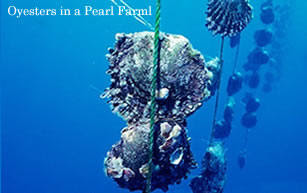Learn about Origin of Pearls

Valuable pearls occur in the wild, but they are very rare. These are called Natural Pearls. They are formed inside the shell of certain mollusks: as a defense mechanism to a potentially threatening irritant such as a parasite inside its shell, injuring the mantle tissue. The mollusk creates a pearl sac to seal off the irritation. Pearls are grown artificially by implanting (nucleated) an irritant and then allow the mollusk to create a pearl sac, as a counter reaction by secreting nacre to surround the object or irritant. This develops into a Cultured Pearl. The whole process is called Pearl Farming.
These cultured pearls make up nearly 100% of the pearls sold today. In a Pearl Farm, several thousand oysters are nucleated and then cared for during this period. Around 2-5 years are required for a pearl to grow and develop. Pearl farms can be set up in rivers, lakes or oceans, depending on whether you want to grow Freshwater or Saltwater pearls. To grow properly, oysters and mollusks need clear, tranquil waters at a temperature of about 20-30º C (or about 68-86º F). Like any other form of farming, pearl farming can be as dependent on luck as it is on skill. An entire bed of oysters can be completely devastated by unpredictable

and uncontrollable factors, such as water pollution, severe storms, excessive heat or cold, disease and many other natural and man-made phenomena. Although pearl farmers attempt to control as many of these variables as possible, pearl farming can indeed be a risky business!


The First Step:– The first step in the pearl production process is to obtain oysters to be nucleated. In the early days of the cultured pearl industry, oysters were simply collected from the sea. Although some farmers continue using this method today, many use the more modern practice of breeding their own oysters. To do this, the pearl farmer collects oyster sperm and eggs from high-quality oysters already on the farm. The sperm are used to fertilize the eggs, and so create a new generation of oyster larvae. Over a period of a few months, the larvae develop into baby oysters. They are generally then moved into a separate “nursery” area of the farm. Here they are tended for around 1-2 years, until they have grown sufficiently large to be nucleated.


The Process Of Nucleation In Pearl Farming:- The process of nucleation is a surgical procedure, whereby a foreign object is implanted into the oyster. This object causes irritation, which the oyster counteracts by secreting nacre to surround the object; this produces the pearl. Two basic methods of nucleation are used. Saltwater oysters are generally nucleated using a “bead”, prepared from mother-of-pearl. First, the bead is surrounded by a small piece of mantle tissue taken from a donor oyster. The bead and tissue are then implanted into the oyster’s gonad. The bead serves as a mold, or nucleus, around which the pearl develops. The resulting pearl will contain the bead at its center and will tend to develop in the same general shape as the original bead. The bead can be detected in the final pearl by x-rays.


Freshwater mussels are generally grafted using a piece of mantle tissue only, without a bead. This small piece of mantle tissue is placed into an incision in the host mussel’s mantle instead of the gonad. An average freshwater mussel will produce 24 to 32 pearls per culturing cycle.
Finally, The Pearls Are Harvested:
After the pearls have been allowed to develop fully, they must be harvested. After the pearls are extracted from the oysters, they are washed, dried, and sorted into general categories. Sometimes, the pearls are polished by tumbling in salt and water. The pearls are then sold to jewelers, manufacturers, and pearl dealers.
Check out Some Stunning Pearl Jewellery at https://www.suratdiamond.com/






